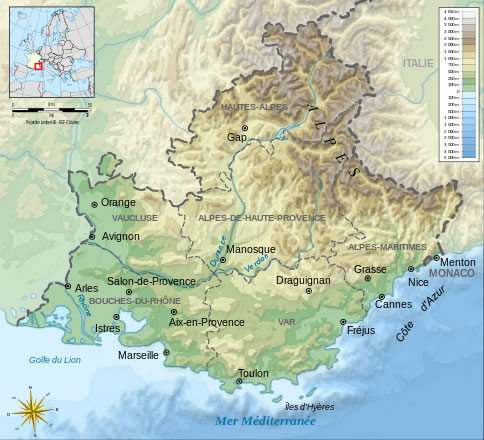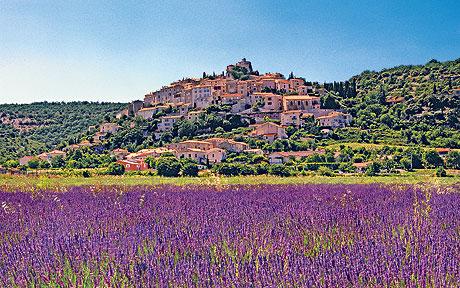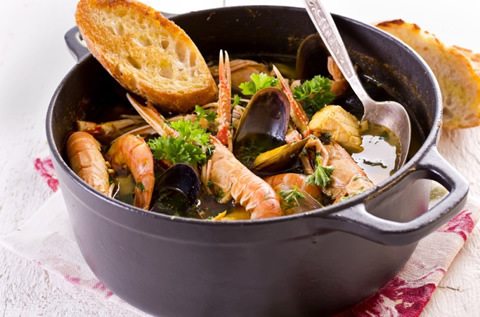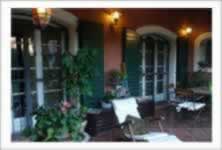The Region Provence-Alps-Cote D'Azur
 Between mountains and sea
Between mountains and sea
The region Provence Alps Cote d'Azur has a wonderful setting: the Mediterranean Sea borders its southern part and the Alps is its frontier with Italy at the north east. The area boasts a wide range of landscapes, it is made of mountainous areas, coastal reliefs, plains and marshlands. Provence has scenery and highlights to satisfy the most discerning visitor.
There is truly something for everyone to discover in Provence whether it is your first visit or you are one of the many visitors who return every year... Provence is one of the most visited regions of France.
The region includes six French 'Departments': Alpes-de-Haute-Provence, Alpes-Maritimes, Bouches-du-Rhone, Hautes-Alpes, Var and Vaucluse.
Alpes-Maritimes
In the coastal region of the Alpes Maritimes you can visit such famous resorts as Cannes, Nice and Antibes. As well as these, our favourite towns on the coast here include Menton and Villefranche-sur-Mer, and the principality of Monaco is also very interesting to visit.
Alpes-de-Haute-Provence
The most visited tourist destination in the Alpes-de-Haute-Provence are the Gorges du Verdon, a dramatic gorge usually explored from Castellane and near the southern border of the department, and the nearby Lac de Sainte-Croix.
Var
Var, to the south of Provence, includes some beautiful coastline and renowned riviera resorts such as Saint-Tropez. Also along the coast, some of the most beautiful scenery can be found in the Port Cros National Park and the Iles of Porquerolle and d'Hyeres which are just off the Var coast.
Vaucluse
The Vaucluse department in north-west Provence is one of our favourite departments in France, with a perfect combination of scenery and traditional villages, there is no coastline in this part of Provence!
Bouches-du-Rhone
The Bouches-du-Rhone department is to the south-west of Provence and has a wide diversity of landscapes from the protected marshy landscapes of the Camargue region, usually explored from the pleasant resort of Saintes-Maries-de-la-Mer, to the dramatic coast east of Marseille which includes the white cliffs of the Calanques at Marseille near Cassis and the Route des Cretes to La Ciotat which follows the coast along the top of the highest sea cliffs in France.
Hautes-Alpes
The northern department of Provence is the Hautes-Alpes department, and is an area of great natural beauty with the Ecrins National park and the Natural Regional Park of Queyras together occupying a large area of the department.
Provence and its major attractions
- Stunning coastline from south-east of Marseille to Cassis where sheer white cliffs meet turquoise seas
- Avignon and its unique "Palace of the Popes"
- Saintes-Maries-de-la-Mer and Camargue land with its wilderness unique in France
- Aix en Provence with its lovely squares and markets
- Old Port and the church Notre Dame de la Garde in Marseille
- Baux-de-Provence is an exceptional village in a lovely setting
The Weather
 The Provence-Alpes-Côte d'Azur region, is renowned for its hot temperatures and pleasant climate throughout the year and especially for its sunny and dry weather during the summer months.
The Provence-Alpes-Côte d'Azur region, is renowned for its hot temperatures and pleasant climate throughout the year and especially for its sunny and dry weather during the summer months.
The region benefits from 2835.5 sunshine hours a year and is the hottest place of France. However, there is a noticeable climate difference between the littoral and inland. Indeed, because of its numerous reliefs the temperature can be relatively low on the mountains while being really gentle on the coast during the winter time.
During summer months, the weather and climate in the Provence region can be quite cool and fresh on the mountains while being really hot on the coast as well as dry and muggy inland. A particularity of this region remains the wind called the Mistral which can sometimes be particularly violent.
Provence-Alpes-Côte d'Azur is a quite dry region due to its Mediterranean climate and if the rainfalls are rare along the coast, they are pretty heavy though.
Gastronomy
 French gastronomy in the Provence-Alpes-Côte d'Azur is very distinctive from the rest of French cuisine or French cooking. A Mediterranean influence brings recipes with hot spices and seafoods (particularly cod and anchovies) than most other parts of France. Because of the mountainous country, without the rich farmlands and herds of dairy cattle, Provencal cooking uses very little milk, and goat cheeses are predominant. Garlic, olive oil and olives are the leitmotif, and the abundant "Herbes de Provence" (is an assortment of herbs containing some combination of thyme, sage, rosemary, basil, lavender, savory, fennel seed, marjoram, tarragon, oregano, and bay leaf) are the spirit of Beyond's Provencal recipes.
French gastronomy in the Provence-Alpes-Côte d'Azur is very distinctive from the rest of French cuisine or French cooking. A Mediterranean influence brings recipes with hot spices and seafoods (particularly cod and anchovies) than most other parts of France. Because of the mountainous country, without the rich farmlands and herds of dairy cattle, Provencal cooking uses very little milk, and goat cheeses are predominant. Garlic, olive oil and olives are the leitmotif, and the abundant "Herbes de Provence" (is an assortment of herbs containing some combination of thyme, sage, rosemary, basil, lavender, savory, fennel seed, marjoram, tarragon, oregano, and bay leaf) are the spirit of Beyond's Provencal recipes.
There are a number of dishes that Provence is famous for, Bouillabaisse is their classic seafood stew made with an assortment of fish and shellfish, tomatoes, garlic, saffron, herbs, wine and olive oil. Bourride is similar to bouillabaisse except that it does not have tomato and is thickened with aioli, a garlic mayonnaise, and another traditional Provencal concoction. Pistou is the Provencal equivalent of pesto and used as a sauce, condiment and as a flavoring agent in soupe au pistou, Provence’s version of Minestrone.
Another famous appareil is tapenade, a ground mixture of olives, anchovies, capers, olive oil and lemon juice.
While the archetypal Provence wine is a Cotes de Provence rosé, it is the smaller, more peripheral appellations that really make the region interesting to wine enthusiasts. In the far east of Provence, the perfumed wines of the tiny Bellet appellation are made in the tightly ridged hills above Nice. The far west is home to the organic reds and rosés of the geologically distinctive Les Baux-de-Provence. The two most famous individual names from the region are located right on the Mediterranean coast between Marseille and Toulon. Here, the deeply colored, richly flavored reds of Bandol are produced just 12 miles (19km) from the herby, full-bodied whites of Cassis.














